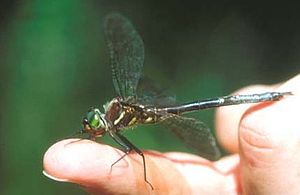Somatochlora hineana
| Somatochlora hineana | ||||||||||||
|---|---|---|---|---|---|---|---|---|---|---|---|---|

Somatochlora hineana |
||||||||||||
| Systematics | ||||||||||||
|
||||||||||||
| Scientific name | ||||||||||||
| Somatochlora hineana | ||||||||||||
| Williamson , 1931 |
Somatochlora hineana is a member of the family of the falcon dragonflies (Corduliidae), which belongs to the large dragonflies (Anisoptera). The species is named after the collector of the holotype James S. Hine . It is considered one of the most threatened species in the United States.
features
Males of Somatochlora hineana measure between 58 and 59 millimeters; Females are slightly larger, reaching 60 to 63 millimeters. In males, 38.5 to 41 millimeters of this amount to the abdomen ; in females it is 41 to 45 millimeters. The abdomen shines greenish-black from the fourth segment. The second and third segments are dark brown, and the first is grayish-brown in color. In addition to the basic color, there is also a drawing that consists of the following parts: On the second segment, under the auricles, there is a larger light yellow spot. The genital lobes are also light yellow except for their edges. There is also a light yellow ring on the edge, which is interrupted on the top. The third segment begins with two lateral spots that almost touch each other on the upper side and expand towards the rear in such a way that they appear almost triangular. In addition, the entire abdomen - but especially on segments five with eight - is covered with small hairs.
The abdominal appendages are about three and a half millimeters in the males just as long as the ninth and tenth segments together. In females they reach four millimeters and are about one and a half times the length of the vulvar lamina . The upper appendages of the males are almost cylindrical at the base and run parallel. About in the middle they begin to point and then slowly run towards each other.
The foremost segment of the chest , the so-called prothorax , is brown and has light yellow front edges. The rest of the thorax is primed brown and shimmers green or blue. There are light yellow stripes on the sides. They get a little wider from front to back. The first is still a millimeter wide, the last 1.3 millimeters. Furthermore, the regions between the wings are also light yellow. The thorax is lighter in color towards the bottom and then merges into the light brown of the insect legs.
The wings are transparent. While the anal triangle is yellowish, the membranes are smoky brown and the edge of the costal region is brownish. The veins are black and the three millimeter long wing mark ( pterostigma ) is dark brown. The pair of hind wings in males is between 41 and 41.5 millimeters long and between 11.5 and 12.5 millimeters wide. The wings of the females reach between 40.5 and 41.5 millimeters in length and a width of 13 millimeters.
The approximately nine millimeters wide head of Somatochlora hineana is light yellow in the area of the labium and the upper lip ( labrum ). The middle of the labrum is also slightly darker or has a small point. In females this pattern is black. The sides of the clypeus , the lower part of the frons and the occiput are ocher in color. The upper part of the fron is dark metallic green. The adjoining vertex is brownish and sometimes has yellowish points on both sides. The back of the head is black.
Way of life and habitat
Somatochlora hineana flies in Alabama , Illinois , Indiana , Missouri , Mississippi , Ohio, and Wisconsin between June and July . It mainly populates marshland , the waters of which have pH values between 7.7 and 8.3. When hunting, both males and females cover about ten to 25 meters and fly at a height of about one to three meters. To defend their territory, however, males usually only fly up to four meters and do not exceed heights of two meters. During the 45-second mating , the dragonflies in the mating wheel fly to low bushes. The eggs are then laid by the females in shallow water.
supporting documents
- ↑ a b T.E. Vogt, Everett D. Cashatt: Distribution, Habitat, and Field Biology of Somatochlora hineana (Odonata: Corduliidae) , Annals of the Entomological Society of America, 87 (5): pp. 599-602, 1994
- ↑ James George Needham, Minter Jackson Westfall, Michael L. May: Dragonflies of North America , ISBN 0-945417-94-2
literature
Thomas W. Donelly: Somatochlora hineana, A new Species of Dragonfly from Eastern Texas.) , In: Proceedings Entomological Society Washington 64 (4): pp. 235-240, 1962
Web links
- Somatochlora hineana inthe IUCN Red List of Threatened Species 2013.1. Posted by: Abbott, JC & Cashatt, E., 2007. Retrieved September 24, 2013.